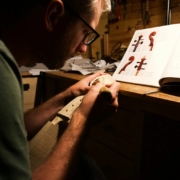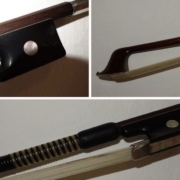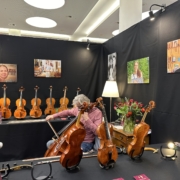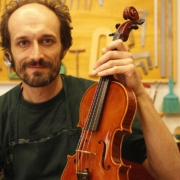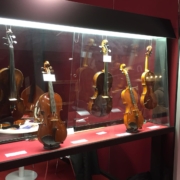Rene Schmidt – modern violins makers and their instruments deserve a fair chance
- We often have customers from abroad, especially from other continents, who come to our shop in Vienna with the desire to buy an Austrian violin. Can you tell us a bit about what is an Austrian violin and the tradition of violin making in Austria (since when it dates, who are the main makers and where it stands in comparison with Italian and German schools for example, how can one distinguish a violin made here)
The tradition of violin making in Austria dates back to the 16th century and is closely related to the development of music in Central Europe. While the Italian and German violin making schools were already well established in the 17th century, violin making in Austria developed its own unique style, incorporating and refining elements from both traditions.
One of the most important Austrian violin makers from this period was Jakob Stainer, who worked in Tirol, Austria. Stainer’s instruments were highly valued across Europe and rivaled in popularity the already famous Italian violins.
Other noteworthy Austrian violin makers emerged in Vienna and in Graz. In Viennna we have Stadlmann family, Leidolff family, Sebastian Dallinger, Johann Georg Thir family, Matthias Thir, Franz Geissenhof, Johann Martin Stoß and in Graz Alois Max Palfner, Wolfgang Sagmayr, Johann Michael Alban, Johann Jauck, Salzburg, Marcell Pichler, Johann Schorn, Andreas Ferdinand Mayr
- Do you have a favorite Austrian maker? Which one is your favorite maker?
I’m frequently asked this question, and I find it challenging to single out just one ‘favorite violin maker’. There are countless instruments that inspire me. I am equally fascinated by exceptionally beautiful instruments and those that might not be considered as such—after all, beauty is in the eye of the beholder. Stradivari, del Gesù, Stainer, Montagnana, da Salò, Maggini, Gofriller, Bergonzi, Ruggeri, Geissenhof and many others, both renowned and lesser-known masters of string instrument making, from historical figures to contemporary artisans, they all share a common passion — transforming the natural material of wood into instruments that, in the best cases, stand the test of time. With craftsmanship and sensitivity, they turn wood into works of art, enabling musicians to convey emotions such as hope, joy, sorrow, change and longing to their listeners—a truly moving process. I deeply admire all violin makers who carry this dedication within themselves.
- There is one preconception that old violins are better. We personally know from experience and from seeing lots of violins that this is not always the case. What is your opinion on this?
Sound, in my opinion, is highly subjective, which is why sound descriptions often hold little significance for me. What one person perceives as ‘focused’ or ‘bright’ might be considered ‘shrill’ by someone else. I believe that when newly built violins are well played-in and their sound has developed, they can easily compete with the tonal qualities of old instruments—or even surpass them.
There are violin tests where musicians, blindfolded and with their noses covered (yes, old violins can indeed be recognized by their smell!), play instruments for an audience in the same condition (blindfolded and nose covered). In such tests, newer, contemporary instruments often outperform those of the old masters. Of course, there are old violins with particularly beautiful tones, but it’s important to note that many of these instruments have numerous repairs and most have been converted from baroque to modern setup—they are far from 100% original. I have great admiration for old instruments, especially the craftsmanship of their time, achieved with fewer technical resources. However, modern violin makers and their instruments deserve a fair chance. It’s important not to dismiss them outright by claiming that only old instruments are truly worthwhile, without even giving the new ones a chance to be heard.
- We have two of your violins that we offer for sale in our shop. Can you tell us a bit about them?
The first violin is a personal interpretation of an original Stainer violin (baroque, 1668) with a modern setup, built in 2017. The choice of wood stands out for its simplicity. The ribs, back, and scroll are made from less flamed local maple, while the top features exceptionally fine and straight growth rings. Both woods originate from the ‘Totes Gebirge’ in the ‘Salzkammergut’ region. This wood selection gives the violin a simple yet elegant appearance. The oil varnish is lightly antiqued and the ebony crown along with the grafted neck are intended to imitate a baroque-to-modern conversion. The contour of the upper bout is kept flat, as in the original, which hints at the instrument’s original baroque neck-to-body connection (flush glued to the ribs and fixed with nails). The fittings (pegs, tailpiece, and chinrest) are made of boxwood.
The second violin is a personal interpretation of the ‘Il Cannone’, 1743, by Guarneri del Gesù. This violin was built in 2020 as the second instrument for my master’s examination. The back, ribs, and neck are made of well-flamed Bosnian maple, and the spruce top is very fine-grained alpine spruce. The varnish, also an oil varnish, has been slightly antiqued. The standout feature of this violin is the inlay work on the back.
- What is your starting point when you decide to build a violin, what inspires you and what is the philosophy behind your work?
Before I start building a new string instrument, I draw inspiration from various sources – books, internet, and especially my ‘screenshot album’ on my phone. At this point, this album is so full that my phone constantly notifies me that the storage is full. Often, I have no choice but to delete photos to make room for new ideas. However, these inspirations serve only as a starting point. I don’t create 1:1 copies or bench copies, as I find that unexciting. Instead, I am often fascinated by details like a particular varnish color or specific antiquing techniques.
The true creative process unfolds for me during the building itself. The fundamental elements, such as geometry, always remain constant – they are essential for the instrument to withstand the forces acting on it and for the musician to feel comfortable with it right away. I place great importance on individuality. Preset thicknesses for the top and back seem unwise to me, as each piece of wood is unique and should be treated accordingly. Only then can the optimal sound potential be extracted.
Each of my instruments is one-of-a-kind, custom-made to suit the properties of the individual wood. This is where I see the true art in violin making. Currently, I am working on my own models for violins and cellos. My focus is on outlines, archings, and the use of alternatives to tropical woods – especially for fingerboards, pegs, as well as upper and lower nut. There is a wealth of old instruments and their copies.
We live in the 21st century, and after over 400 years of violin making history, it’s time to take new paths and develop own models. It’s time to break the myth that only old instruments are valuable and sound good.

